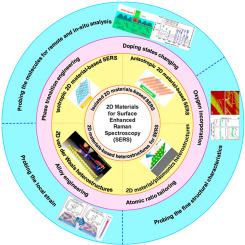Materials Today Physics ( IF 10.0 ) Pub Date : 2021-03-02 , DOI: 10.1016/j.mtphys.2021.100378 Zhen Yin , Kaichen Xu , Shouzhen Jiang , Dan Luo , Rui Chen , Chunxiang Xu , Ping Shum , Yan Jun Liu

|
Surface-enhanced Raman spectroscopy (SERS) has become an ultrasensitive technique in trace molecule detection through its unique vibrational fingerprint. However, development of a SERS platform with large enhancement factor, superior stability, and excellent reproducibility is still a grand challenge for practical applications. Recently, two-dimensional (2D) materials play an intriguing role for SERS through the use of their unique structures and properties. This review summarizes the recent progress of 2D materials-based SERS that could be complements to plasmonic SERS substrates. Based on the symmetry of the lattice structure, isotropic and anisotropic 2D materials for SERS are introduced. Particularly, various methods to improve the SERS performance are described. The sensitivity, limit of detection, and stability are discussed for 2D materials-based heterostructures as SERS platforms, including van der Waals and hybrid heterostructures. Furthermore, the applications of 2D materials-based SERS substrates in niche areas, including local strain probing, remote/in-situ chemical analysis, and fine structure characterization are summarized.
中文翻译:

用于表面增强拉曼光谱的二维层状材料及其应用的最新进展
表面增强拉曼光谱(SERS)通过其独特的振动指纹图谱已成为痕量分子检测中的超灵敏技术。然而,开发具有大的增强因子,优异的稳定性和优异的可再现性的SERS平台仍然是实际应用中的巨大挑战。近年来,二维(2D)材料通过使用其独特的结构和特性,对SERS起到了吸引人的作用。这篇综述总结了基于二维材料的SERS的最新进展,它可以作为等离子SERS基板的补充。基于晶格结构的对称性,介绍了用于SERS的各向同性和各向异性的二维材料。特别地,描述了改善SERS性能的各种方法。灵敏度,检测限,讨论了基于二维材料的异质结构作为SERS平台的稳定性和稳定性,包括van der Waals和混合异质结构。此外,总结了基于2D材料的SERS基底在利基领域的应用,包括局部应变探测,远程/原位化学分析和精细结构表征。











































 京公网安备 11010802027423号
京公网安备 11010802027423号